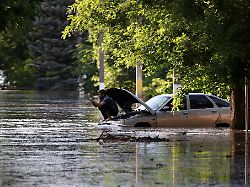Blasted Ukraine Dam
“It was a freshman exercise”
By Marko Schlichting
6/7/2023 2:43 am
An explosion destroys the Kakhovka Dam in Ukraine this morning. Water masses penetrate into the Cherson region. Thousands of lives are threatened. In the ZDF talk show Markus Lanz, two experts speak of an attack.
The pictures are hard to believe. Huge masses of water are rushing out of the Kakhovka dam in southern Ukraine, flowing into the Dnieper and flooding the area around the city of Cherson. Thousands of people have to be evacuated from the region. In the morning an explosion shook the dam and tore a huge hole in the dam wall. In the ZDF talk show Markus Lanz, two experts who try to explain the situation have their say on Tuesday evening.
The dam is one of the largest in Europe. It is a good 30 meters high and more than three kilometers long. The resulting reservoir holds up to 18 billion cubic meters of water, nine times the volume of Lake Chiemsee. These water masses are now threatening about 80 places in the Kherson Oblast. The town of Nova Kakhovka on the Russian side of the Dnieper is flooded. Power outages are reported on social media. There is a lack of drinking water. The authorities have declared a state of emergency. The Magdeburg professor of hydrodynamics, Daniel Bachmann, explains to Markus Lanz that repairing the dam is not possible under these circumstances.
He and his colleagues used a hydrodynamic model to calculate what could happen in the next few days. He expects the water in the affected towns to rise by up to 30 centimeters per minute. It could flow at a speed of two to three meters per second, a little faster than a normal person jogs. According to their theoretical model, up to 19,000 lives could be in acute danger.
In the meantime, the first aid measures have started. The dam is located on the Dnieper, the right bank of which is in Ukrainian hands. The villages have been evacuated here since Tuesday. But the left bank of the Dnieper is in Russian-occupied Ukraine. It’s deeper, and that’s why the people there are even more threatened. Little is known about their location.
Accident or blast?
There are several explanations for the cause of the disaster. Some experts speak of an ordinary accident. Bachmann doesn’t think so. “Actually, a structure like this doesn’t simply fail,” he says. “Something like this is usually announced in advance. You have measuring points and safety devices at a reservoir like this.” However, the dam had been part of the front for months. Bachmann cannot say whether in this case the measuring devices were used as they were in peacetime. Nevertheless: He does not assume a “purely technical failure”.
Political scientist and safety expert Christian Mölling does not believe in an accident either. He assumes a targeted explosion. Here he clearly sees the advantage in Russia. “Although there are some colleagues who start from the idea that the dam should be blown up just a little to raise the water level and thus make it impossible for Ukrainian forces to cross over.” If that’s true, the dam would have been blown up almost by accident. That’s entirely possible, say experts, because the Russians have dumped mines there. However, one question remains: shouldn’t the Russian army know the locations of their own mines?
One of the Russian war aims could be to prevent the Ukrainian army from crossing the Dnieper. But in the planned Ukrainian offensive it is more of a secondary theater of war. Nevertheless, after crossing, the Ukrainian forces could have tried to attack Russian positions and tie down the troops on site, according to Mölling. This is no longer possible – and no longer necessary. Because the water masses are now also destroying the Russian positions in the region.
Mölling considers it unlikely that the Ukrainian army is responsible for blowing up the dam. “It could, however, simplify its civilian operations,” he explains. “But then they would be endangering their own people. I doubt that the government can justify to the international community and its own people that this was an appropriate war maneuver.”
Both sides would now have to reassess the military situation, says Mölling. And the current situation cannot bring anyone an advantage. “If I may put it that way: From a military point of view, it was a first-semester exercise,” the expert concluded. Incidentally, reports by US secret services have now become known. They indicate that the Russian army was to blame for the blowing up of the Kachowka dam.
